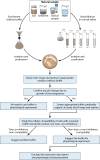Optimizing experimental conditions: the role of buffered environments in microbial isolation, physiological studies, and taxonomic characterization
- PMID: 40366183
- PMCID: PMC12175527
- DOI: 10.1128/aem.01728-24
Optimizing experimental conditions: the role of buffered environments in microbial isolation, physiological studies, and taxonomic characterization
Abstract
Using a buffered medium is considered essential for enriching and cultivating novel microbial taxa, studying their pH range and optima, and conducting different physiological experiments. Experimental evidence showed that different buffer compounds impact microbial physiology and cell growth differently, and some of them exert toxic and inhibitory effects on organisms under study. Laboratory growth media supplemented with incompatible buffers could also suppress the organism's growth. Therefore, the selection of buffers without the knowledge of their implications on cell growth and physiology in such experiments yields an inaccurate estimate of their physiological abilities and pH range and optima. In this paper, the authors argue against the use of buffered medium to enrich and isolate novel taxa and suggest determining the pH range and optima using unbuffered medium for taxonomic description and physiological characterization. Based on previous literature and our observations, we recommend the use of rich universal laboratory growth medium with their pH adjusted using 1 N NaOH and/or 1 N HCl for such studies, except in cases where the organism cannot grow in such media. However, the pH of the growth medium must be continuously monitored, and in cases where the medium's buffering capacity is compromised, a suitable pH buffer with only a neutral effect on cell growth must be used for more accurate physiological experiments with that organism in the future. Based on the inhibitory effects of buffers on different cells (prokaryotes and eukaryotes) and physiological activities, in this manuscript, we also recommend that the compatibility of the buffers should be first screened before starting any physiological experiments, and any buffer compound should be avoided in the culture medium during the designing of the culturomics protocols for the cultivation of novel taxa from natural samples.
Keywords: novel bacterial taxa; organic buffers; pH range and optima.
Conflict of interest statement
The authors declare no conflict of interest.
Figures



References
-
- Jiang J, Wang Y-P, Yu M, Cao N, Yan J. 2018. Soil organic matter is important for acid buffering and reducing aluminum leaching from acidic forest soils. Chem Geol 501:86–94. doi: 10.1016/j.chemgeo.2018.10.009 - DOI
-
- Marques M, Schwilch G, Lauterburg N, Crittenden S, Tesfai M, Stolte J, Zdruli P, Zucca C, Petursdottir T, Evelpidou N, Karkani A, AsliYilmazgil Y, Panagopoulos T, Yirdaw E, Kanninen M, Rubio J, Schmiedel U, Doko A. 2016. Multifaceted impacts of sustainable land management in drylands: a review. Sustainability 8:177. doi: 10.3390/su8020177 - DOI
-
- Neina D. 2019. The role of soil pH in plant nutrition and soil remediation. Appl Environ Soil Sci 2019:1–9. doi: 10.1155/2019/5794869 - DOI
-
- Xu R, Zhao A, Yuan J, Jiang J. 2012. pH buffering capacity of acid soils from tropical and subtropical regions of China as influenced by incorporation of crop straw biochars. J Soils Sediments 12:494–502. doi: 10.1007/s11368-012-0483-3 - DOI
-
- Hueso-González P, Muñoz-Rojas M, Martínez-Murillo JF. 2018. The role of organic amendments in drylands restoration. Curr Opin Environ Sci Health 5:1–6. doi: 10.1016/j.coesh.2017.12.002 - DOI
Publication types
MeSH terms
Substances
Grants and funding
LinkOut - more resources
Full Text Sources

